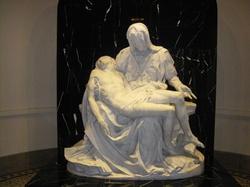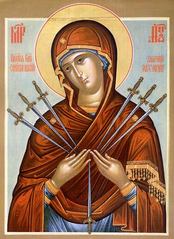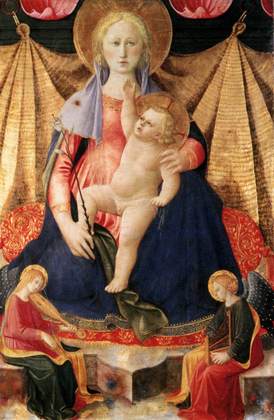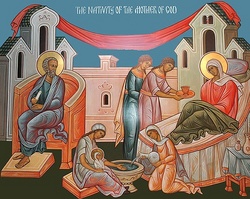Father, as your Son was raised on the cross, his
mother Mary stood by him, sharing his sufferings. May your Church be united
with Christ in his suffering and death and so come to share in his rising to
new life, where he lives and reigns with you and the Holy Spirit, one God, for
ever and ever. Amen.
Today's feast of the Blessed Virgin Mary follows
yesterday's feast of the Triumph of the Cross. As the liturgical year
progresses we see some things change in the liturgical atmosphere as we
prepare, believe it or not, for the end of the liturgical year: our focus on
the Paschal Mystery of the Lord (i.e., the life, death, resurrection &
ascension of the Lord) becomes more present to us.


Liturgically the Church dedicates
a day to the spiritual martyrdom of Mary, Jesus' own mother. The feast of Our Lady of Sorrows has not only a spiritual depth but a real human one: it strikes at the core of our heart. What human being goes through life
without some sort of pain? Like all mothers, Mary was wounded and pained at
various times in her life by the absence of her son and the pain and death he
had to suffer. No mother delights in her child's misery, no mother sits by
while her child's humanity is in jeopardy. Consider what the mothers of
soldiers go through waiting for her son or daughter to return from war. Imagine
the terrible, heart wrenching pain that many mothers felt when they were told
their child was killed in Iraq. I know of the pain my own paternal grandmother faced when her son was killed in a car accident more than 40 years ago; a pain that never truly healed nor spoken of...
The feast we observe today reminds us of the
humanity of not only Mary, but of Jesus. For as we know, Mary always points to
her son: the cross brought incredible suffering for Jesus while it saved all of
humanity by trampling down sin and death; Careful observing the suffering as Mary did requires our attention, too,
because Christ saved us in and through our humanity. This point is driven home
countless times a day as I walk past a replica of Michelangelo's Pieta (see the pic above); I am
confronted with the sorrowing Mother Mary holding the dead body of her son in
her arms, the very arms which cuddled him as an infant.
The Cistercian monks
and Servite friars have given the Church an apt liturgical feast to indicate
the depth of humanity Mary had in standing by her son, an experience foretold
by Simeon. The feast has also be called Our Lady of Compassion, yet another
intersection of theology and human reality.
Here are the seven sorrows of
Mary:


The prophecy of Simeon (Luke 2:25-35)
The flight into Egypt (Matthew
2:13-15)
Loss of the Child Jesus for three days (Luke 2:41-50)
Mary meets Jesus
on his way to Calvary (Luke 23:27-31; John 19:17)
Crucifixion and Death of
Jesus (John 19:25-30)
The body of Jesus being taken from the Cross (Psalm 130;
Luke 23:50-54; John 19:31-37)
The burial of Jesus (Isaiah 53:8; Luke 23:50-56;
John 19:38-42; Mark 15:40-47)

 You have been blessed, O Virgin Mary, above all other women on earth by the Lord, the Most High God, for God has so exalted your name that human lips will never cease to praise you.
You have been blessed, O Virgin Mary, above all other women on earth by the Lord, the Most High God, for God has so exalted your name that human lips will never cease to praise you.


